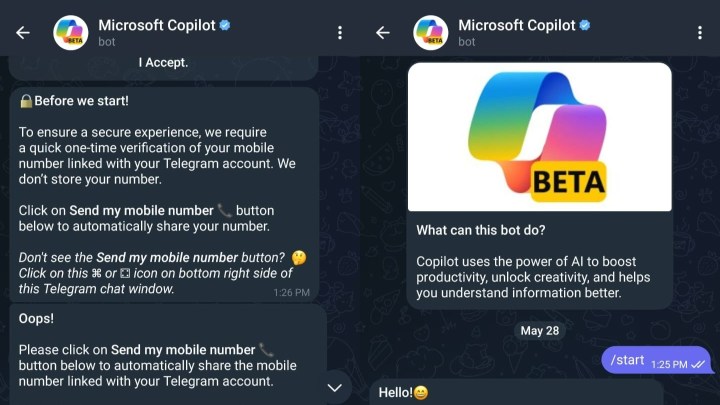
It’s not just you — Microsoft is putting Copilot just about anywhere, and now it’s available on Telegram as a bot that’s part of its “copilot-for-social” project. Windows Latest reports that to use the bot, you’ll need to confirm your phone number by sending your contact in the chat. The company is expanding its AI integration into one of the most popular messaging apps, but it might not end there.
Microsoft claims that it won’t save your phone number for anything other than verification, but it’s needed because the service is currently unavailable for anyone in the EU, at least for now. If anyone in the EU tries to access it, they will be blocked.
“To ensure a secure experience, we require a quick one-time verification of your mobile number linked with your Telegram account. We don’t store your number,” Microsoft says in a message you see when you start using the bot.
You can use the bot for free, and it looks like the Copilot social integration might not stop with Telegram since the project claims to bring it to other messaging apps such as WhatsApp. So far, there is no information on how it will be part of WhatsApp, but we’ll keep you posted when more information becomes available. We’ll have to wait and see if Copilot reaches WhatsApp and if you can access it when you want, like in Telegram, or if it pops out when it thinks you need it.
You can find the Microsoft Copilot bot by typing @CopilotOfficialBot in the search bar, but be careful when selecting from the search results since other bots imitate the Copilot logo. Ensure that the option you select has the verification badge. You can use three commands with the bot: /restart (restarts the chat), /share (share the bot with friends), and /ideas (shows you how you can use the bot).
The Copilot bot has a daily limit of 30 messages daily, and is based on GPT-4, GPT-3.5, and Microsoft’s in-house models. So far, swapping between the Precise, Creative, and Balanced models is impossible. Copilot has been on everyone’s minds with Microsoft’s various announcements about it at its annual Build Developer Conference this year.
Editors' Recommendations
- Why Samsung has the most exciting Copilot+ PC right now
- The first Copilot+ PC has been tested — and it destroys the MacBook
- What are Copilot+ PCs? Your most pressing questions, answered
- All the Copilot updates announced at Build 2024
- Microsoft has a killer answer for DLSS with Copilot+



